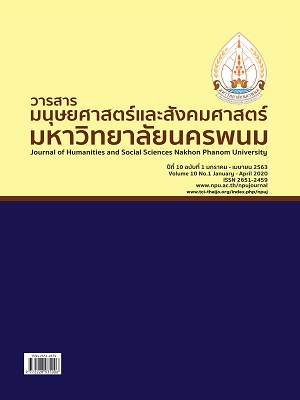การวิเคราะห์จำแนกปัจจัยที่มีอิทธิพลต่อการปลูกข้าวเกษตรอินทรีย์และไม่ใช้เกษตรอินทรีย์ ตำบลหนองโบสถ์ อำเภอนางรอง จังหวัดบุรีรัมย์
Main Article Content
บทคัดย่อ
การวิจัยนี้มีวัตถุประสงค์เพื่อ 1) เพื่อวิเคราะห์จำแนกกลุ่มปัจจัยที่มีอิทธิพลต่อการปลูกข้าวของเกษตรกร
2) เพื่อสร้างสมการจำแนกกลุ่มในการคาดคะเนความเป็นสมาชิกของเกษตรกรที่ปลูกข้าวเกษตรอินทรีย์หรือปลูกข้าวไม่ใช้เกษตรอินทรีย์ กลุ่มตัวอย่างที่ใช้ในการวิจัย ได้แก่ เกษตรกรที่ปลูกข้าวเกษตรอินทรีย์หรือปลูกข้าวไม่ใช้เกษตรอินทรีย์ จำนวน 381 คน ซึ่งแบ่งออกเป็น 2 กลุ่ม คือ เกษตรกรที่ปลูกข้าวเกษตรอินทรีย์ จำนวน 129 คน และเกษตรที่ปลูกข้าวไม่ใช้เกษตรอินทรีย์ จำนวน 252 คน เครื่องมือที่ใช้ในการวิจัย ได้แก่ แบบสอบถามมีค่าสัมประสิทธิ์แอลฟ่าของครอนบราชเท่ากับ 0.843 สถิติที่ใช้ในการวิเคราะห์ข้อมูลได้แก่ ค่าร้อยละ (Percentage) ค่าเฉลี่ย (Mean) ส่วนเบี่ยงเบนมาตรฐาน (Standard Deviation) และการวิเคราะห์จำแนกกลุ่ม (Discriminant Analysis) แบบขั้นตอน (Stepwise Method)
ผลการวิจัยพบว่า 1) ปัจจัยที่สามารถจำแนกการปลูกข้าวเกษตรอินทรีย์และไม่ใช้เกษตรอินทรีย์ ได้แก่ เพศ, อายุ, สถานภาพ, ระดับการศึกษา ประสบการณ์ประกอบอาชีพ สภาพครองที่ดิน ,การจำหน่ายผลผลิตทางการเกษตรของเกษตรกร, สถานภาพทางสังคม ,ท่านมีความรู้เกี่ยวกับการปลูกข้าวเกษตรอินทรีย์มากน้อยเพียงใด ,ท่านสามารถใช้วิธีธรรมชาติหรือวัสดุธรรมชาติอื่นใด เพื่อจัดการกับปัญหาวัชพืชในแปลงนาโดยไม่ใช้ยาฆ่าหญ้า,ท่านสามารถใช้วิธีธรรมชาติหรือวัสดุธรรมชาติอื่นใด เพื่อจัดการกับปัญหาเพลี้ยกระโดดในนาข้าวโดยไม่ใช้สารเคมีกำจัดแมลงมากน้อยเพียงใด, การใช้สารเคมีในการปลูกข้าว และการกำจัดพืช แมลงศัตรูพืชส่งผลต่อสุขภาพมากน้อยเพียงใด,ข้อมูลข่าวสารมีอิทธิพลในการตัดสินใจเลือกปลูกข้าวเกษตรอินทรีย์มากน้อยเพียงใด,การปลูกข้าวอินทรีย์สามารถช่วยลดการทำลายความสมบูรณ์ของดินและน้ำมากน้อยเพียงใด 2) ตัวแปรทั้ง 13 ตัวแปร สามารถจำแนกกลุ่มเกษตรกรได้ถูกต้องร้อยละ 95.8 โดยสามารถแสดงสมการจำแนกกลุ่มในรูปคะแนนดิบและคะแนนมาตรฐานได้ดังนี้
สมการจำแนกกลุ่มในรูปคะแนนดิบ
สมการจำแนกกลุ่มในรูปคะแนนมาตรฐาน
Article Details
เอกสารอ้างอิง
บุญเริง พลายแก้ว (2551). การผลิตข้าวหอมมะลิตามระบบจัดการคุณภาพเกษตรดีที่เหมาะสมของ เกษตรกร จังหวัดมุกดาหาร. ปริญญาเกษตรศาสตรมหาบัณฑิต แขนงวิชาส่งเสริมการเกษตร สาขาส่งเสริมการเกษตรและ สหกรณ์ มหาวิทยาลัยสุโขทัยธรรมาธิราช.
พรชัย หาระโคตร และ อรุณ ทองอุ่น. (2551). ผลของการจัดการน้ำและระยะปลูกต่อการเจริญเติบโตและผลผลิต ของข้าวพันธุ์ไรซ์เบอร์รี่ภายใต้ระบบการผลิตแบบประณีต (SRI). วารสารวิทยาศาสตร์และเทคโนโลยี 24(6), 986-997.
รัฐพงษ์ จันทคณานุรักษ์, ศุภพร ไทยภักดี และ พันธ์จิตต์ สีเหนี่ยง. (2558). ปัจจัยด้านเศรษฐกิจของเกษตรกรกับการพัฒนาการเกษตรในเขตปฏิรูปที่ดินเพื่อเกษตรกรรม ตำบลลำนางรอง อำเภอโนนดินแดง จังหวัดบุรีรัมย์. วารสารวิชาการ 8(3), 314-328.
สมคิด ดิสถาพร (2556). แนวทางการผลิตพืชอินทรีย์. กรมวิชาการเกษตร กระทรวงเกษตรและสหกรณ์.
สุพรรณี เลขกลาง, ปัญญา หมั่นเก็บ และ ทิพวรรณ ลิมังกูร (2551). ปัจจัยที่มีอิทธิพลต่อการผลิตข้าวอินทรีย์ของเกษตรกรในจังหวัดสุรินทร์. การประชุมทางวิชาการของมหาวิทยาลัยเกษตรศาสตร์ ครั้งที่ 49: สาขาส่งเสริมการเกษตรและคหกรรมศาสตร์.
อรกช เก็จพิรุฬห์. (2555). การสร้างแรงจูงใจในการปลูกข้าวอินทรีย์ด้วยการวิจัย. Journal of Community Development Research 5(1), 113-124.
อรวรรณ ศรีโสมพันธ์. (2557). โครงสร้างการผลิตและการตลาดข้าวหอมมะลิไทย (รายงาน ผลการวิจัย). กรุงเทพฯ: สำนักประสานงานวิจัยเชิงนโยบายเกษตรและการเสริมสร้างเครือข่ายงานวิจัยเชิงนโยบาย สนับสนุนโดยกองทุนสนับสนุนการวิจัย (สกว.) และสถาบันคลังสมองของชาติ.
Translated Thai References
Rittinon, C. and M. Uruyos. Effect of Leadership on Organic Farming Adoption Decision. Applied Economics Journal. 24(1), 23-27. [in Thai]
Plaikaew, B. (2008). Rice production quality management system according to Good Agricultural Practices province's farmers. Master Degree of Agriculture Agricultural fields Cooperative Extension and Agricultural University Thammatirat Sukhothai Kingdom. [in Thai]
Harakhote, P. and A. Thongaun. (2008). Effects of water management and crop growth and yield. Rice varieties of berries under the intensive production system (SRI). Journal of Science and Technology, 24 (6), 986-997. [in Thai]
Chankananurak, R. (2015). Economic factors of Farmers and Agricultural Development in the Agricultural Land Reform Lam, starring Non Din Daeng district. Buriram province. Academic Journal 8 (3), 314-328. [in Thai]
Ditsathaphon, S. (2013). The organic crop production. Department of Agriculture Ministry of Agriculture and Cooperatives. [in Thai]
Lakklang, S., P. Mankeb. and T, Limunggura. (2008). Factors that influence the production of organic rice farmers in Surin. Symposium of the 49th Kasetsart University Faculty of Agriculture and
Home Economics. [in Thai]
Kagephirun, O. (2012). Creating incentives for organic rice research. Journal of Community Development Research 5 (1), 113-124. [in Thai]
Srisompun, O. (2014). Production Structure and Marketing of Thai Jasmine Rice. (Research Report). Bangkok: Office of Coordination and Agricultural Policy Research Network to strengthen research policy. Supported by Research Fund (TRF). Institutional and brains of the nation. [in Thai]
Yamane, T. 1973. Statistics: an Introductory Analysis. Harper & Row, New York. 1130 p.


